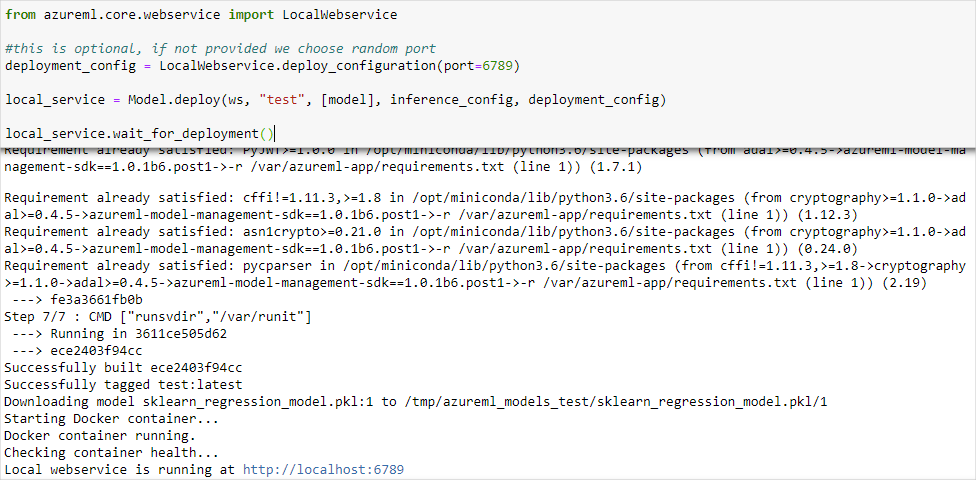你当前正在访问 Microsoft Azure Global Edition 技术文档网站。 如果需要访问由世纪互联运营的 Microsoft Azure 中国技术文档网站,请访问 https://docs.azure.cn。
重要
本文提供有关使用 Azure 机器学习 SDK v1 的信息。 SDK v1 自 2025 年 3 月 31 日起弃用。 对它的支持将于 2026 年 6 月 30 日结束。 可以在该日期之前安装和使用 SDK v1。 使用 SDK v1 的现有工作流将在支持结束日期后继续运行。 但是,当产品发生体系结构更改时,它们可能会面临安全风险或中断性变更。
建议在 2026 年 6 月 30 日之前过渡到 SDK v2。 有关 SDK v2 的详细信息,请参阅 什么是 Azure 机器学习 CLI 和 Python SDK v2? 以及 SDK v2 参考。
了解如何使用 Azure 机器学习将模型部署为 Azure 机器学习计算实例上的 Web 服务。 如果满足下列任一条件,则请使用计算实例:
- 你需要快速部署并验证你的模型。
- 正在测试一个开发中的模型。
提示
将模型从计算实例上的 Jupyter Notebook 部署到同一 VM 上的 Web 服务是本地部署。 在这种情况下,“本地”计算机是计算实例。
注意
Azure 机器学习终结点 (v2) 提供了经过改进的更简单的部署体验。 终结点同时支持实时和批量推理方案。 终结点提供了一个统一的接口,可跨计算类型调用和管理模型部署。 请参阅什么是 Azure 机器学习终结点?。
Prerequisites
- 一个有计算实例运行的 Azure 机器学习工作区。 有关详细信息,请参阅创建帮助入门的资源。
部署到计算实例
用于演示本地部署的示例笔记本包含在计算实例中。 使用以下步骤加载笔记本,并将模型部署为 VM 上的 Web 服务:
在 Azure 机器学习工作室中,选择“笔记本”,然后在“示例笔记本”下选择 "how-to-use-azureml/deployment/deploy-to-local/register-model-deploy-local.ipynb"。 将此笔记本克隆到用户文件夹。
查找步骤 1 中克隆的笔记本,选择或创建计算实例以运行该笔记本。

笔记本会显示其上有服务运行的 URL 和端口。 例如,
https://localhost:6789。 还可以运行包含print('Local service port: {}'.format(local_service.port))的单元格以显示端口。
若要从计算实例测试服务,请使用
https://localhost:<local_service.port>URL。 若要从远程客户端进行测试,请获取在计算实例上运行的服务的公共 URL。 可以使用以下公式来确定公共 URL;- 笔记本 VM:
https://<vm_name>-<local_service_port>.<azure_region_of_workspace>.notebooks.azureml.net/score。 - 计算实例:
https://<vm_name>-<local_service_port>.<azure_region_of_workspace>.instances.azureml.net/score。
例如,
- 笔记本 VM:
https://vm-name-6789.northcentralus.notebooks.azureml.net/score - 计算实例:
https://vm-name-6789.northcentralus.instances.azureml.net/score
- 笔记本 VM:
测试服务
若要将示例数据提交到正在运行的服务,请使用以下代码。 将 service_url 值替换为在上一步获取的 URL:
注意
对计算实例上的部署进行身份验证时,将使用 Microsoft Entra ID 进行身份验证。 对示例代码中 interactive_auth.get_authentication_header() 的调用将使用 Microsoft Entra ID 对你进行身份验证,并返回一个标头,然后可使用该标头向计算实例上的服务进行身份验证。 有关详细信息,请参阅为 Azure 机器学习资源和工作流设置身份验证。
对 Azure Kubernetes 服务或 Azure 容器实例上的部署进行身份验证时,将使用不同的身份验证方法。 有关详细信息,请参阅针对部署为 Web 服务的 Azure 机器学习模型配置身份验证。
import requests
import json
from azureml.core.authentication import InteractiveLoginAuthentication
# Get a token to authenticate to the compute instance from remote
interactive_auth = InteractiveLoginAuthentication()
auth_header = interactive_auth.get_authentication_header()
# Create and submit a request using the auth header
headers = auth_header
# Add content type header
headers.update({'Content-Type':'application/json'})
# Sample data to send to the service
test_sample = json.dumps({'data': [
[1,2,3,4,5,6,7,8,9,10],
[10,9,8,7,6,5,4,3,2,1]
]})
test_sample = bytes(test_sample,encoding = 'utf8')
# Replace with the URL for your compute instance, as determined from the previous section
service_url = "https://vm-name-6789.northcentralus.notebooks.azureml.net/score"
# for a compute instance, the url would be https://vm-name-6789.northcentralus.instances.azureml.net/score
resp = requests.post(service_url, test_sample, headers=headers)
print("prediction:", resp.text)